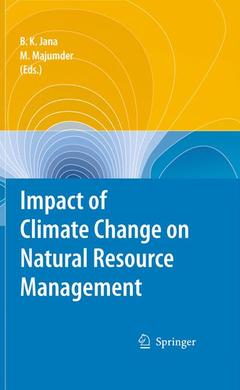Description
Impact of Climate Change on Natural Resource Management, Softcover reprint of the original 1st ed. 2010
Coordinators: Jana Bipal Kr., Majumder Mrinmoy
Language: English
Subjects for Impact of Climate Change on Natural Resource Management:
Keywords
Artificial desertification; Biomass Carbon; Carbon Sequestration; Distributed Hydrologic Simulation; Global warming; Hydrology Climate Change; Industrialisierung; Neurogenetic Models; Remote Sensing; climate change; hydrology; climate change impacts; hydrogeology; remote sensing/photogrammetry
Publication date: 08-2016
Support: Print on demand
Publication date: 07-2010
493 p. · 15.5x23.5 cm · Hardback
Description
/li>Contents
/li>Biography
/li>Comment
/li>
As climate change takes hold, there is an ever-growing need to develop and apply strategies that optimize the use of natural resources, both on land and in water. This book covers a huge range of strategies that can be applied to various sectors, from forests to flood control. Its aim, as with resource management itself, is to combine economics, policy and science to help rehabilitate and preserve our natural resources.
Beginning with papers on carbon sequestration, including the practice of artificial desertification, the topics move on to cover the use of distributed modeling and neural networks in estimating water availability and distribution. Further chapters look at uncertainty analysis applied to the spatial variation of hydrologic resources, and finally the book covers attempts at estimating meteorological parameters in the context of hydrological variables such as evapo-transpiration from stream flow.
Within the next decade, the effects of climate change will be severe, and felt by ordinary human beings. This book proposes a raft of measures that can mitigate, if not reverse, the impact of global warming on the resources we have all come to depend on.
The following authors contributed with their articles: Prof. Dr. Asis Mazumdar (BME, MME, PhD (Jadavpur University (JU)) who is the Director of School of Water Resources Engineering and Co-ordinator of Regional Center, National Afforestation and Eco-development Board; Dr. Debasri Roy (PhD (Calcutta University)) is a Reader of the School of Water Resources Engineering; Dr. Pankaj Kr. Roy (BCE (National Institute of Technology, Silchar), ME, PhD(JU)), Dr. Rajib Das (BE (Utkal University), ME (JU), PhD (Pisa)) are the Lecturers and Mr. Sanjib Das (BE (JU) is the Technical Assistant of the School of Water Resources Engineering; Mr. Arnab Barua (BEE (West Bengal University of Technology (WBUT)), ME(JU), Mr. Biswajit Majumder (BE (National Institute of Technology, Agartala (NITA), ME(JU)), Miss Debapriya Basu (BEE (WBUT), ME (JU) and Mr. Sabyasachi Pramanik (BChE (WBUT), ME (JU)) are the former Master of Engineering students of School of Water Resources Engineering; Mr. Rabindra Nath Barman (BME, ME, PhD (submitted) (JU)) is the Assistant Professor of NITA; Mr.Sashi Sonkar and Miss Suchita Dutta are the Junior Research fellow and Research Assistant of Regional Center, National Afforestation and Eco-development Board whereas Mr. Chinmoy Boral is presently doing his PhD at the School of Water Resources Engineering, Jadavpur University.
The book was compiled by Mr. Bipal K. Jana (MSc (CU), PhD (submitted) (JU)) and Dr. Mrinmoy Majumder (BEE (Biju Patnaik University of Technology), ME, PhD (JU)).
Bipal Jana is Senior Research Fellow in the School of Water Resources Engineering. He has more than 17 years of experience in the fields of environmental engineering and management. He has completed his bachelor and master degrees in Science at Calcutta University and MBA (P G D Environmental Management) at the Indian Institute of Social Welfare and Business Management(IISWBM). He has authored over 10 papers in national and international publications.
Mrinmoy Ma
Comprehensive overview of new methodologies and computational methods, and impact of man-made structures on natural resources
Detailed examinations of such techniques as Clean Development Mechanism, Environmental Impact Assessment, Remote Sensing, GIS and Watershed Management
Discusses implications of climatic variations which can be used in research projects
Includes case studies on methodologies and results from different approaches to hydrologic estimation
Includes supplementary material: sn.pub/extras




